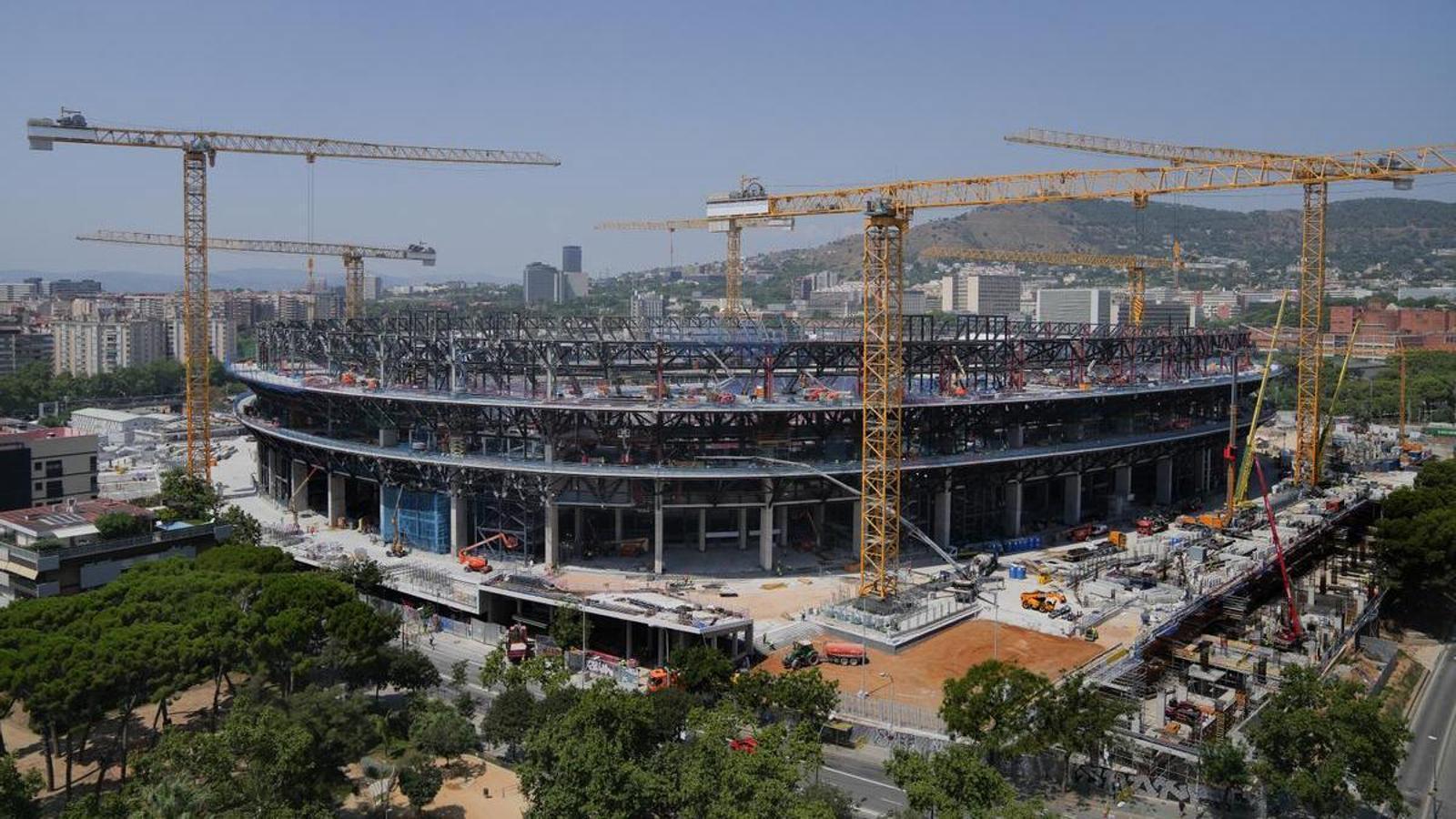A walk inside the Camp Nou construction site
This is what the stadium looks like with just a month left until the stadium reopens against Valencia in La Liga.


BarcelonaThere's one month left until D: the weekend of September 14th, Barça's first home game in La Liga. In other words, there's one month left until Camp Nou reopens – if nothing goes wrong –Through the eyes of architects, workers, and technicians, ARA has prepared a text explaining the status of the construction work on a stadium that is in full swing.
The routine of working on the construction site makes one lose sight of the scale of the renovation. With the hustle and bustle of everyday life, one enters and exits without paying attention. Now, when someone who hasn't set foot there for a while stops, they realize the majesty of the new Camp Nou. Many things are already hinted at from Travessera de les Corts, but from the access points, one can admire the third tier, dubbed by the club as the "crown jewel" of the remodeling. Construction has progressed so much that today the talk of a return is very optimistic; nothing like what was happening just a few weeks ago, when no one saw it as a given, not even the City Council.
Access controls are strict. First, you have to identify yourself and then go through the rotating queues, where only one person can fit. These have been there for a while, but for a while they hadn't worked, so someone not involved with the construction site had even sneaked in. Today, you need a special card, in addition to the vest and helmet. The first impression, aside from the gigantic dimensions of the construction, is that the work outside is progressing very quickly. This is largely due to the incredible number of people working, comparable only to the crowds seen in movies about the Egyptians building pyramids.
Sand is being dumped to level the ground and pave the exterior entrance to the stadium.
Still outside, the main concrete structures are already done. Also the diamonds, which are small concrete spaces that rise to the surface. Once completed, they are intended to serve as a shop, an entrance to the museum, an entrance for opposing fans at the north goal, or even as a member service area. For now, they will remain unfinished, as they are not a priority for reopening. However, the paving is. That's why large quantities of sand are being poured at ground level to level the ground and pave it. It's the easiest and most economical option. If you want to lay paving stones later—as Núñez did in his time—there's always time.
The large columns of the new third tier mark the entrance to the stadium. Signs are already being installed at the various gates. Many season ticket holders will have difficulty finding their way around on the first day because everything is different. But that's even better. The renovation has served to simplify the entrance. The labyrinth of stairs that previously led to the first tier has been replaced with a flat, accessible entrance. For the time being, there are no elevators, and you'll have to climb to the second floor using wide, comfortable stairs. One of the advantages of redesigning the third tier is that it has gained a lot of space and has opened up an area that was sometimes claustrophobic. Now there's plenty of room. This is also possible for emergency evacuation, even while construction is underway.
Access to the third tier ring is restricted. As this is the first phase of construction, a safety harness is required. So, with the exception of those assigned a task, the rest of the workers who want to be onlookers have to watch from the top of the second tier. The feeling is that it will be difficult to reopen this space in January, as the club had predicted a few months ago, and that the work will drag on throughout the season. In contrast, the grandstand, the sideline, and the south goal are nearly complete and look equally finished. In the eyes of experts, it wouldn't be surprising if the City Council granted permits in mid-September for all three areas. However, work is more bogged down on the north goal, still with scaffolding and some access points closed. It doesn't seem feasible that it will be given the green light until well into October.
The construction work has left a lot of dirt that will need to be cleaned up before the Camp Nou's doors can open.
It's been a long time since it rained in Barcelona. Between this and the daily construction work, Camp Nou looks dirty and dusty. Nothing that can't be fixed with a good cleaning crew. However, it's starting to be urgent that they get started. The main parking lot is already paved and painted, although it's whitewashed by the dust that also covers many of the interior walkways and the more than 60,000 folding chairs for spectators. There are two exceptions: the seating area. VIP, perfectly covered with tarps to prevent it from deteriorating prematurely, and the box, which is the first area ordered to be cleaned. Probably because inspectors from the League and UEFA will be passing by in a few days.
The final turf has been installed, and the temptation to sit somewhere is almost irresistible. The slope of the first tier has been corrected, and visibility from the front rows has been significantly improved. An LED lighting system has also been installed, serving both aesthetic and safety purposes. However, it's striking that the traditional railings that delimited the different areas of the stands are gone. Perhaps they will be installed later, but for now, you can walk from one of the goals to the grandstand without any hindrance.
The locker rooms and the access tunnel to the pitch are essential areas that need to be finished.
In the lower part of the stands, the optimistic balloon is deflating a little. There are still urgent things to be polished, such as the locker room, where the players' individual lockers are just being installed. Time is running out, and the question of where the players will change is being asked. Or the access tunnel to the pitch, which should be cleaning by now. The benches still have no seats, and in the middle, the wiring is being installed to assist the referee with the VAR.
Everyone assumes the work won't be finished in 2026, but will have to wait at least until 2027. But the rush to return is already evident. Without football, the renovation could have been completed in three years. Combining it with matches is another matter. Barça has taken a firm stand. The stress is evident, especially among Limak's top officials in a summer when few will be taking vacations. In construction, everyone says it's essential to have a date for handing over the keys, because that's the only way to keep everyone on the same page.
